Corn Season Is Here
go.ncsu.edu/readext?1064094
en Español / em Português
El inglés es el idioma de control de esta página. En la medida en que haya algún conflicto entre la traducción al inglés y la traducción, el inglés prevalece.
Al hacer clic en el enlace de traducción se activa un servicio de traducción gratuito para convertir la página al español. Al igual que con cualquier traducción por Internet, la conversión no es sensible al contexto y puede que no traduzca el texto en su significado original. NC State Extension no garantiza la exactitud del texto traducido. Por favor, tenga en cuenta que algunas aplicaciones y/o servicios pueden no funcionar como se espera cuando se traducen.
Português
Inglês é o idioma de controle desta página. Na medida que haja algum conflito entre o texto original em Inglês e a tradução, o Inglês prevalece.
Ao clicar no link de tradução, um serviço gratuito de tradução será ativado para converter a página para o Português. Como em qualquer tradução pela internet, a conversão não é sensivel ao contexto e pode não ocorrer a tradução para o significado orginal. O serviço de Extensão da Carolina do Norte (NC State Extension) não garante a exatidão do texto traduzido. Por favor, observe que algumas funções ou serviços podem não funcionar como esperado após a tradução.
English
English is the controlling language of this page. To the extent there is any conflict between the English text and the translation, English controls.
Clicking on the translation link activates a free translation service to convert the page to Spanish. As with any Internet translation, the conversion is not context-sensitive and may not translate the text to its original meaning. NC State Extension does not guarantee the accuracy of the translated text. Please note that some applications and/or services may not function as expected when translated.
Collapse ▲Preparing for the Corn Season
April 1st may signal the beginning of spring, but for corn farmers in Eastern NC, it means corn season has arrived. Pamlico County residents may have noticed the flurry of activity occurring in local fields in preparation for the coming season. This includes fertilizer and weed control applications, drainage management activities, and tillage operations. In this article I will provide a quick insight into how corn is grown in Pamlico County.
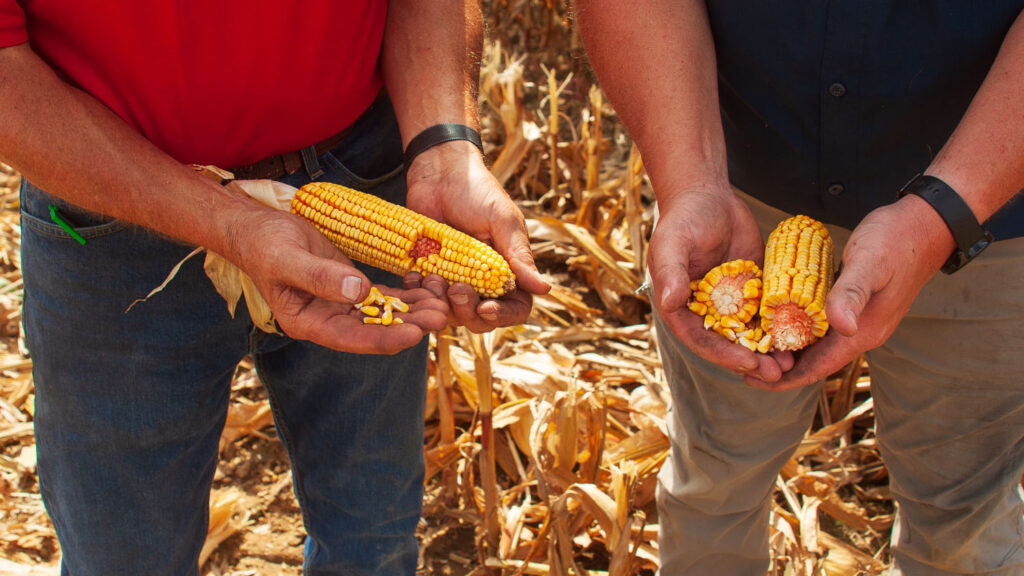
Farmers inspect dried corn cobs, showing the kernels that will be harvested once the field is ready. Early preparation is key for a successful corn season.
The Modernization of Corn Farming
The days of horse drawn equipment are long past as modern agriculture has evolved to become more efficient. This efficiency is driven by low commodity prices, ever increasing input costs, and the need to produce more bushels of corn on fewer acres and with fewer people to remain profitable.
Farming as a Business
Just as a reminder to our readers, farming is a business, and unless farms remain profitable, they cannot continue to produce crops. To this end, many decisions about the current crop were made several months ago. This included selecting seed corn based upon yield performance, collecting soil samples, amending soil fertility to optimize growth, and simply deciding how many acres could be planted based upon price and cost projections that change daily.
Corn Planting Process
Once planting has begun, corn seed is placed into the ground to a depth of about 2 inches. From this moment onward, mother nature dictates how the season unfolds.
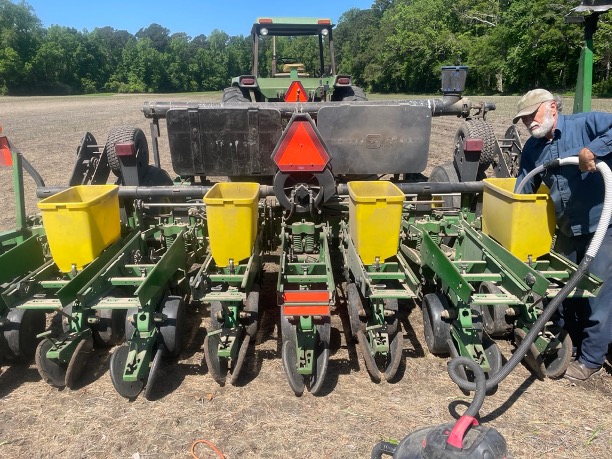
A farmer vacuums out the corn planter, ensuring the equipment is ready for planting. Proper setup is critical to ensure efficient seed placement for optimal growth.
Germination and Weather’s Role
For optimal germination to occur, corn seeds need adequate moisture and the accumulation of a specific number of hours of warm temperatures above 50 degrees. With sufficient temperatures, most of the seeds planted will germinate within 5-7 days after planting and rise uniformly above the soil within a 24-hour period. If cool temperatures prevail, germination is delayed and corn seed will struggle to arise uniformly. This inconsistency reduces corn yield by 8-10%, as the earliest plants to arise will out compete late comers.
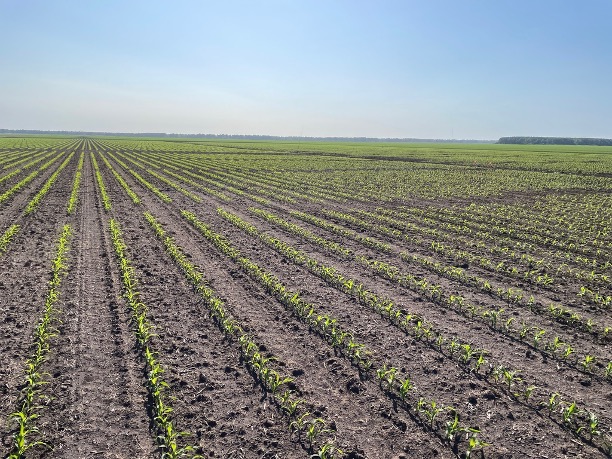
In the V-4 stage of growth, corn plants are just beginning to sprout, signaling the start of a healthy growing season.
Managing Crop Stress and Fertilization
When corn plants reach the V-7 stage (plant has 7 leaves), the number of kernel rows around the cob becomes set. Any significant stress at this period (wet, dry, fertility) can decrease the number of kernels rows, which can have a large impact on yield potential. Around this V-7 stage, growers will begin to apply additional nitrogen fertilizer and provide additional weed control. This may sound simple, but these two actions will probably be the last actions that growers can take to affect yield. Nitrogen fertilizer is essential to optimal growth and yield potential.
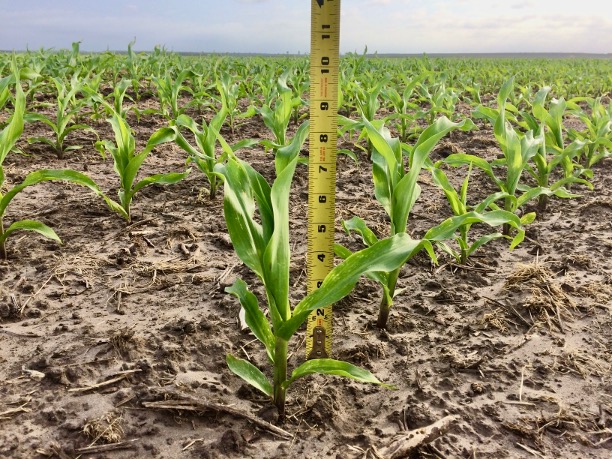
At the V-7 stage, corn plants are about 8 inches tall. This crucial growth phase sets the number of kernel rows around the cob, impacting overall yield.
Impact of Weather, Nitrogen, and Weeds
However, if heavy rains occur early in the growing season, large amounts of nitrogen that was applied before planting, and nitrogen naturally available within the soil, could be lost to leaching and denitrification (microbes release nitrogen into the atmosphere when soil oxygen is low). If growers do not account for these potential losses, corn plants will run out of nitrogen later in the season resulting in a reduction in yield. Similarly, weeds compete for water, sunlight, and nutrients and must be controlled to produce a profitable yield. If weeds out compete young corn plants early in the season, as much as 50% of the yield potential can be lost and never recovered.
The Tassel Stage and Beyond
Once plants reach the VT tassel stage (tassels are male flowers at the top of corn plants), corn plants are sufficiently tall to shade out most weed competition. Plant height also limits most field activity as ground equipment can no longer traverse the crop without damage.
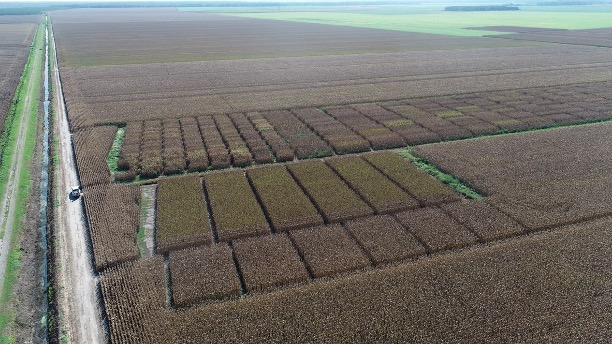
Aerial view of a mature corn field, where rows of corn are nearing the drying phase. As the season progresses, farmers closely monitor conditions to protect their yield.
Challenges During the Growing Season
From this point forward, the corn crop is subject to mother nature and farmers can only hope that their preparations early in the season will support a robust plant that can endure environmental stress until harvest. However, once harvest arrives farmers must still compete with hurricanes, as they rush to harvest corn before storms degrade grain quality or reduce yield from wind damage and flooding.
Road Safety During Corn Harvest
From this brief article, I hope readers understand that corn production in Pamlico County is all about preparation and early season activity. You have or will soon encounter tractors, planters, and other farm equipment moving across fields and along highways. Please be cautious on highways as this equipment is slow moving and needs space to avoid mail boxes, signs, and others items alongside roadways. When passing equipment, please be mindful that this equipment cannot stop easily to help you avoid collisions. Share the road and enjoy the journey, and you just may notice that corn field when it starts to grow.
Contact Information for More Details
For more information on corn production or other crops in Pamlico County, you can contact Daniel Simpson, Agricultural Extension Agent, at 252-745-4121 or Daniel_simpson@ncsu.edu.



